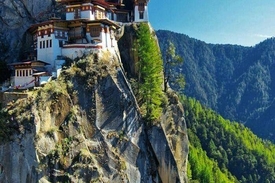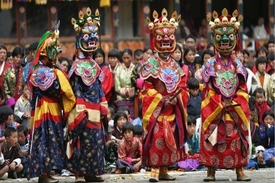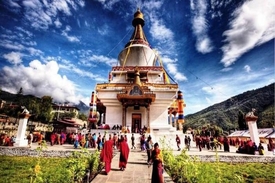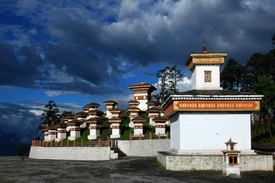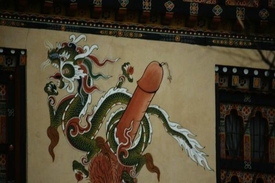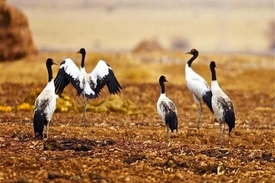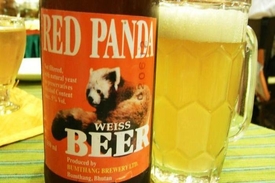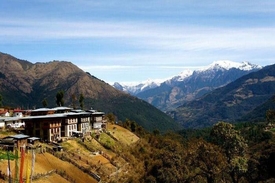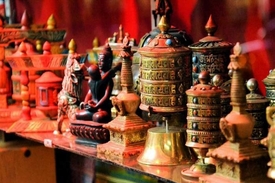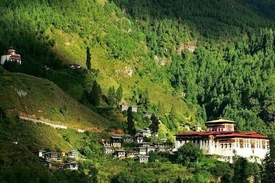Bhutan, a Buddhist kingdom on the Himalayas’ eastern edge, is known for its monasteries, fortresses (or dzongs) and dramatic landscapes that range from subtropical plains to steep mountains and valleys. In the High Himalayas, peaks such as 7,326m Jomolhari are popular trekking destinations. Paro Taktsang monastery (also known as Tiger’s Nest) clings to cliffs above the forested Paro Valley.
Day 01 Arrive Paro
The flight to Paro Bhutan airport is one of the most spectacular mountain flights in the world, a constantly changing panorama of the some of the highest mountains on the earth.
The charming town of Paro lies on the banks of the Paro (or Pa) Chhu, just a short distance northwest of the imposing Paro Dzong. The main street, only built in 1985, is lined with colourfully painted wooden shop fronts and restaurants, though these appear under threat as the town grows and multi-storey concrete buildings continue to propagate. For now Paro remains one of the best Bhutanese towns to explore on foot and is worth an hour or two’s stroll at the end of a day of sightseeing.
We will be checking into the hotel that combines the culture, heritage and architecture of Bhutan, with 21st century comfort and technology.
In the afternoon, we can visit some of the iconic sites of Paro.
• Paro Rinpung Dzong – The Paro Dzong is one of Bhutan’s most impressive and well-known dzongs, and perhaps the finest example of Bhutanese architecture you’ll see. The massive buttressed walls that tower over the town are visible throughout the valley.The dzong’s correct name, Rinchen Pung Dzong (usually shortened to Rinpung Dzong), means ‘fortress on a heap of jewels’. In 1644 Zhabdrung Ngawang Namgyal ordered the construction of the dzong on the foundation of a monastery built by Guru Rinpoche.
• Paro Weekend Market – Paro’s weekend market isn’t very large but it has a traditional feel and is a fine introduction to some of Bhutan’s unique local products, from organic Tsirang honey to the squares of dried jellied cow skin known as khoo (a local snack). The market is busiest on Sunday mornings but the vegetable stalls remain throughout the week. As you wander the stalls, look for strings of chugo (dried yak cheese), either white (boiled in milk and dried in the sun) or brown (smoked). The fruit that looks like an orange egg is actually fresh husky betel nut, imported from India. The jars of pink paste contain lime, which is ingested with the betel nut. There are also exotic-looking ferns, powdered juniper incense, and patties of datse, the cheese used in almost every Bhutanese dish.
• Kyichu Lhakhang – A short drive from Paro is Kyichu Lhakhang, one of Bhutan’s oldest and most beautiful temples. The temple is popularly believed to have been built in 659 by King Songtsen Gampo of Tibet, to pin down the left foot of a giant ogress who was thwarting the establishment of Buddhism into Tibet. Additional buildings and a golden roof were constructed in 1839 by the penlop (governor) of Paro and the 25th Je Khenpo. Elderly pilgrims constantly walk around the temple spinning its many prayer wheels.
Day 02 Paro
After breakfast, we leave Paro freely for sightseeing.
Later, enjoy its wide array of services, which includes:
• Joining the monks at the Meditation House
• Soak up the tranquility of the Tea House
• Enjoy a unique selection of spa treatments imbued with spiritual symbolism
• Unwinding with a drink at the Mad Monk Ba
PLACES OF INTEREST:
• Paro Rinpung Dzong – Rinpung Dzong, also known as “fortress of the heap of jewels “, was built in 1646 by Zhangdrung Rinpochhe. It now houses as administrative and religious centre of Paro Dzongkhag. The approach to the Dzong is through a traditional covered bridge called the Nemi Zam which offers a good view of the architectural wonder of the Dzong as well as life around it.
• Drukgyel Dzong – Drugyal Dzong which means victorious fortress was built in 1646 by Shabdrung to honor his victory over the Tibetan invaders, led by the Mongolian warlord, Gushri Khan in 1644. It was strategically built over the only passage into Paro valley. The glory of Drukgyel Dzong remained even when it was destroyed by fire in 1951.
• Ta Dzong – Ta Dzong (watch tower) built in 1951 to defend Rinpung Dzong during inter-valley wars of the 17th century. It was re-established as the National Museum in 1967 and was rated among the best natural history museums in Asia. It holds mesmerizing collection of art, relics, religious thangkha paintings and Bhutan’s exquisite postage stamps etc. 4. Kyichu Monastery: Kyichu temple is one of the most holy and oldest temples in Bhutan. It was built in 7th Century by the Tibetan King Songtsen Gampo, to subdue the demons that were petrifying the Himalayan countries.
Day 03 Drive – Thimpu (By Road) (55 Kms/1H appx.)(The Capital of Bhutan)
Drive to the capital city of Bhutan, Thimphu is a unique city with unusual mixture of modern development alongside ancient traditions. Although not what one expects from a capital city, Thimphu is still a fitting and lively place.
In the afternoon, visit the following sights:
• National memorial stupa – This stupa was built in 1974 in the memory of Bhutan’s third King, His Late Majesty, King Jigme Dorji Wangchuk, who is popularly regarded as Father of modern Bhutan. The paintings and statues inside the monument provide a deep insight into Buddhist philosophy.
• Institute for the 13 arts and craft (Zorig Chu-sum) – Commonly known as Arts & Crafts School or Painting School, the Institute offers a six-year course on the 13 traditional arts and crafts of Bhutan. On a visit, one can see students learning the various skills taught at the school.
• Weekend market – Every Thursday to Sunday most of Thimphu’s scant population and many valley dwellers congregate on the banks of the river where weekend market is held. It is an interesting place to visit and provides opportunity to mingle with the local people.
Alternatively, you may choose to hike for 3-4 hours, starting from Changangkha Temple, a popular fortress-like temple perching on a ridge, to Kunselphodrang (the Buddha Point), and be rewarded with a spectacular, panoramic view of Thimphu. Kunselphodrang is also famous for the massive statue of Shakyamuni, one of the largest Buddha statue in the world (standing at 51.5 meters). The statue is said to emanate an aura of peace and happiness to the entire world.
Day 04 Drive back to Paro (By Road) (55 Kms. / 1 hr. appx.)
Hike up to the famous Taktsang Monastery
Enjoy breakfast in Thimphu, before making embarking on a 1hr 30mins bus ride back to Paro. We will be visiting the famous Taktsang Monastery, otherwise known as the Tiger Temple (built in 1962). The trail is broad and the walk of approximately 1.5 to 2 hours uphill takes you almost a kilometer above the Paro valley floor (for those who cannot hike we will arrange a horse for transfer up to cafeteria). The view of Taktsang Monastery built on a sheer cliff face 900 meters above the valley floor is a spectacular sight.
The Monastery is also an important pilgrim site for the Buddhists. The great Guru Rimpoche is said to have flown here on the back of a tigress when he brought the teachings of the Buddhist Dharma to Bhutan in the 8th Century. He then mediated in a cave there for three months where the monastery was later built. The cave is said to be the origin of Buddhism in Bhutan. After the hike, guests will return back to the hotel for resting and washing up, before we end the day with the Gala Dinner.
Day 05 Paro Departure
After breakfast, drive to Paro International Airport for the flight to onward destination.
| City | Night (s) | 3* Hotels | 4* Hotels | 5* Hotels |
| Paro | 02 | Metta Resort | Naksel Boutique | Le Meridien |
| Thimphu | 01 | Norbuling Hotel | Druk Thimphu | Le Meridien |
| Paro | 01 | Metta Resort | Naksel Boutique | Le Meridien |
Inclusions
– Welcome with fresh flower garlands.
– Meet assist at the airport and hotels.
– 04 nights accommodation as per the program in the hotels / resorts / Camps of your choice.
– Bhutan Visa Fees.
– Daily breakfast, lunch and dinners.
– Alcohol package during the lunch and dinner every day.
– Welcome Gala Dinner and Farewell Gala Dinner.
– Theme dinners as per your choice.
– Cultural Folk Dance shows with live music.
– All transfers, sightseeing, excursions by private AC vehicle as per the program.
– Accompanying English / German / French / Italian / Spanish / Chinese / Arabic / Korean / Hebrew / Polish / Russian speaking escort cum guide from arrival till departure.
– Entrance fees to the monuments as per the program.
– All taxes.
Activities
– Turban & Saree tying lesson.
– Masala Chai Demonstration.
– Local Cuisine live demonstration.
– Cultural dance show.
– 01 Yoga class.
– 01 dinner of Indian thali.
– Hot Air Balloon Ride.
– Elephant Safari.
– Magic Show.
– Henna Painting.
– Stand-up Comedian.
– Tuk Tuk / Rickshaw Ride.
– Dress in local attire with dinner.
– River Rafting.
– Boat Cruising.
– Hot Stone Bath.
– Astrology & Palm Reading.
– Live Theatre Performance
Branding
– Logo branding on Vehicles.
– Color and logo branding Merchandise.
– Departure gifts with company’s branding.
– Tips.
– International Air Fare.
– Travel & health insurance.
– Personal expenses and drinks.
– Accommodation in good hotels.
– Check-in / out time is 12 noon at most of the hotels.
– Extension to other places is also possible with a minimal extra cost.
– A visa is required and must be obtained prior to your departure from your Country.
– If quoted hotel is not available, we will provide one of a similar category and standard.
– Small deviations in the tour program are sometimes necessary, depending on weather, road conditions, flight schedules and room availability.
– In case the government changes presently applicable taxes, increase in airlines prices, fuel surcharge our rates will need to be adjusted accordingly.
– In Asia, there is no relevance between the distance and time of traveling, as it depends upon the condition of the roads and congestion of the traffic.
– While every effort will be made to maintain the itinerary, in view of local strikes etc that are beyond our control all schedule and itineraries are subject to last moment changes.
– Clients must be fully insured, as the company cannot accept liability for loss or damage to client’s property, medical emergencies or any other loss suffered by them whilst on tour.
– In Case of issuing Domestic or International air tickets, SGV is not responsible for any refund if the flight is delayed or cancelled, as it is the responsibility of airline.



